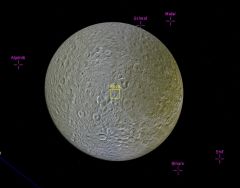Rhea
Jump to navigation
Jump to search
| Rhea | |
|---|---|

| |
| Rhea in Orbiter 2016 with D3D9 client | |
| Designation | |
| Name | Rhea |
| Reference body | Saturn |
| Planetary mean orbits | |
| Epoch | 2005.41409993155 |
| Semimajor axis (a) | 527225476.502165 m |
| Eccentricity (e) | 0.000909561682184622 |
| Inclination (i) | 27.94971857° (0.487814614025395 radian) |
| Longitude of the ascending node (LAN, ☊) | 168.8079837° (2.94625511954542 radian) |
| Longitude of periapsis (ϖ) | 360.9692475° (6.30010186733614 radian) |
| Mean longitude (L) | 448.7342263° (7.83188971564837 radian) |
| Selected physical parameters | |
| Mean radius | 764000 km |
| Mass | 2.49×1021 kg |
| Rotation elements | |
| SidRotPeriod | 390411 seconds (108.4475 hours or 4.5 days) |
| SidRotOffset | 5.23 |
| Obliqutiy | 0.4895 |
| LAN | 6.09808 |
| Note | *Elements given are from Rhea.cfg (outerplanets-050329) |
Rhea is the ninth-largest moon in the Solar System and the second-largest moon of Saturn. Rhea was discovered by Giovanni Domenico Cassini on 23 December 1672 about the same time he discovered Dione, Iapetus, and Tethys, but the name Rhea referred to by John Herschel stuck.
| edit The Solar System | |
|---|---|
| Central star |
Sun (Sol) |
| Planets |
Mercury - Venus - Earth - Mars - Jupiter - Saturn - Uranus - Neptune |
| Natural satellites |
Moon - Phobos - Deimos - Io - Europa - Ganymede - Titan - more... |
| Add-ons |
Planets - Dwarf Planets - Small objects - Natural satellites - Alternative star systems |
 | This natural satellite related article is a stub. You can help Orbiterwiki by expanding it.
|